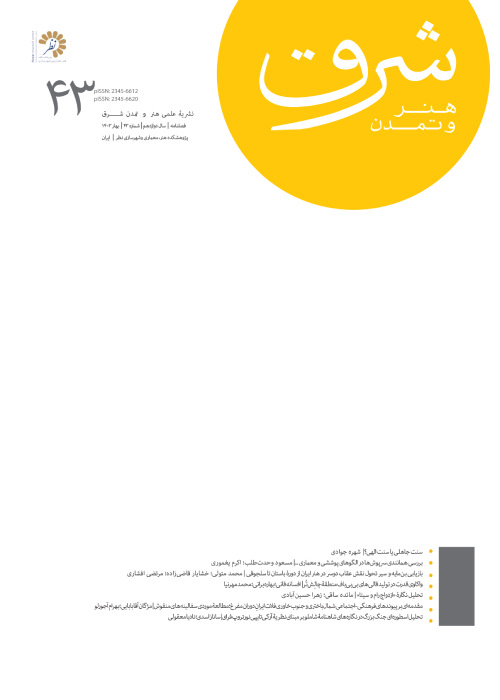Cultural readout of The concept of vitality in Iranian cities
Author(s):
Article Type:
Research/Original Article (دارای رتبه معتبر)
Abstract:
The concept of vitality has been considered by researchers for many years and several norms have been presented for it. But most of these criteria seem to have taken into account the western concept of vitality. It can be said that the criteria of native vitality have received less attention from domestic researchers in Iran. Therefore, it is necessary to re-read the concept of vitality based on Iranian cultural resources. For this purpose, we have tried to access the concept of this category in the Iranian view by using the concept of the vibrant city based on two examples of written cultural works of Hafiz Divan and Medina Al-Fadhil Ibn Arabi. We have compared and adjusted these views with the opinions of contemporary domestic researchers and then with the views of non-Iranian researchers.What similarities or differences can be found between the background of Iranian culture in terms of the desired dynamism and vibrant city and the views of contemporary Persian or non-Persian language experts in this field? The current study aims to examine the degree of conformity of Iranian experts’ views on the vibrant city with the background of Iranian culture.This study analyzes a set of data with a qualitative approach to content analysis which is based on the study of ancient Iranian cultural texts, library information, documents, and the opinions of Iranian and foreign experts. The research methodology has been compiled to formulate the hypotheses of this study and to extract the concept of vitality in Iranian cities based on its cultural resources. In this article, the selection of contemporary Iranian researchers to reflect their makeup has been done based on the amount of use of the basis of the researcher’s significance in the issue of vitality in the cultural space of the West and also the attention of Persian-speaking audiences to their votes. From the conceptual comparison of contemporary definitions, we find that local experts have so far paid more attention to the micro and physical norms of vitality such as pedestrianism and legibility, nightlife, green spaces, diversity and aesthetics, and the most important principle of vitality for them has been the improvement of environment quality. But foreign thinkers have paid attention to the macro-standards of vitality, such as the dynamism of the regional economy, global attractiveness and tourism, resilience, the dynamism of urban areas, the dynamism of neighborhoods, etc. And for them the improvement of environment quality has been only one of the features of liveliness. Difference in these theories can reflect the culture, needs, and attitudes of people in different cultures. In addition, some of the other criteria provided by foreign thinkers improve the quality of people’s presence in the city. However, some of the main criteria provided by Iranian scientists (such as pedestrianism) simply consider the presence of people as the goal. But criteria such as the people’s continuous and bilateral interaction with the government or healthy economic competition lead to a positive, conscious and effective presence of the people in urban spaces. The city is lively and dynamic due to this presence. On the other hand, after studying Farabi and Hafiz’s attitudes to the vibrant city, it was found out that non-Iranian views on the ideal city overlap with a part of the history of Iranian culture. As an example, one can refer to the concept of sense of place and peace in the city desired by Hafiz and Farabi. These concepts have been highly emphasized in the views of Western urban planners. Perhaps the great emphasis of contemporary Persian-speaking scholars on physical concepts can be considered a weak point in the concept of contemporary vibrant Iranian cities.
Keywords:
Language:
Persian
Published:
Journal of Art and Civilization of the Orient, Volume:8 Issue: 28, 2020
Pages:
41 to 52
https://magiran.com/p2143477
دانلود و مطالعه متن این مقاله با یکی از روشهای زیر امکان پذیر است:
اشتراک شخصی
با عضویت و پرداخت آنلاین حق اشتراک یکساله به مبلغ 1,390,000ريال میتوانید 70 عنوان مطلب دانلود کنید!
اشتراک سازمانی
به کتابخانه دانشگاه یا محل کار خود پیشنهاد کنید تا اشتراک سازمانی این پایگاه را برای دسترسی نامحدود همه کاربران به متن مطالب تهیه نمایند!
توجه!
- حق عضویت دریافتی صرف حمایت از نشریات عضو و نگهداری، تکمیل و توسعه مگیران میشود.
- پرداخت حق اشتراک و دانلود مقالات اجازه بازنشر آن در سایر رسانههای چاپی و دیجیتال را به کاربر نمیدهد.
In order to view content subscription is required
Personal subscription
Subscribe magiran.com for 70 € euros via PayPal and download 70 articles during a year.
Organization subscription
Please contact us to subscribe your university or library for unlimited access!


